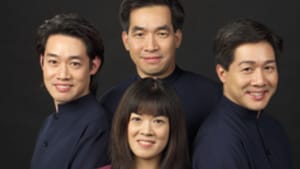Stay in the Loop
BSR publishes on a weekly schedule, with an email newsletter every Wednesday and Thursday morning. There’s no paywall, and subscribing is always free.
Three Slavs by four Asians
Ying Quartet at the Perelman

In the midst of the Philadelphia Orchestra's well-publicized travails, the Chamber Music Society continues to provide some of the city's best music-making. The Ying Quartet's October 28 recital at the Kimmel Center offered quartets by two Russians, Arensky and Shostakovich, and Dvorák's splendid Piano Quintet in A, Op. 81.
The Ying is a youngish ensemble, consisting of three Ying family members— David, Janet and Philip— and the Japanese violinist Ayano Ninomiya. The quartet's stronger players sit on the bass side, and the result is a somewhat throaty sound, though one not inappropriate to a Slavic program.
The Ying group has made a specialty of the chamber works of Anton Arensky (1861-1906), a Tchaikovsky protégé whose influence is evident throughout the attractive and substantial Quartet # 2 in A Minor, Op. 35, particularly in the extended middle movement, a set of variations based on a theme from Tchaikovsky's Op. 54 that, in orchestral elaboration, is Arensky's best-known work.
Arensky's generation is overshadowed by its predecessor— that of Tchaikovsky, Rimsky-Korsakov, and the Mighty Russian Five— and its successor, that of Scriabin and Rachmaninoff. None of his generation's principals— Taneyev, Liadov and Arensky himself— quite produced a major career, although all wrote music of interest.
Much sense of la vielle Russe abounds in Arensky's Quartet, with rich liturgical and folk-sounding melodies as well as the Tchaikovsky tune of which Arensky made more than the master himself. You get the same feel from Turgenev's tales of rural Russia— of wide spaces and a life lived in subjection to nature and tradition.
That's a bit misleading, of course, for late-19th Century Russia was on the brink of great transformations. But then, nostalgia is the key both to much art and to our experience of it. The Ying dug into the music with relish and produced a very satisfying result.
Hummable Schoenberg?
Nothing could have been further removed from the Arensky than the Shostakovich Twelfth Quartet of 1968. The last five of Shostakovich's 15 string quartets are "late" works in much the same sense as are the last five of Beethoven's: They're original in form, deeply introspective and venturing to places where no one had been before.
The Twelfth consists of two movements, but these are broken into subsections that vary sharply in character, tempo and volume. It opens with a low drone figure that serves as a motivating cell for the entire work and is actually a Schoenbergian tone row, although it's hardly developed as such. Schoenberg once expressed the belief that people would some day hum his tone rows the way they did Romantic melody, an event that has yet to come to pass.
Dodecaphonic music had long been proscribed in the Soviet Union as formalist decadence, although Shostakovich had experimented with a tone row in the 15th of his Preludes and Fugues for Piano, Op. 87. With the Eleventh Quartet, he had set about deconstructing traditional melody with truncated thematic phrases that seemed to emerge incompletely from a deep silence.
Silent war
The Twelfth is a more compacted, through-composed work, with much more formal rigor, but it gives much the same effect of a war with silence. This is by no means to suggest a lack of vitality— the Twelfth is a fiercely energetic work— but rather a sense of the void from which all creation emerges, and which continually encroaches on it.
Clearly, this feeling had much to do with Shostakovich's own failing health, as well as the toll of a life lived under the shadow of history's greatest war and one of its greatest tyrannies. That he was able to wrest music that has spoken so universally to the human condition out of his personal torment (violist Philip Ying commented to the audience that Shostakovich's work is now performed more often than that of any other 20th-Century composer) is the more extraordinary for the sense of isolation that surrounds it.
The Ying Quartet's performance itself, while sufficiently vigorous, conveyed a deeply introverted quality. I've heard this work projected with more drama and, I might say, ferocity; but this was certainly a valid and rewarding approach to it.
Pressler as mother hen
After the intermission break, Dvorák's Piano Quintet in A, Op. 81 was a welcome change of pace. The Romantic repertory contains five great piano quintets: the Schubert Trout Quintet, the Schumann E-flat, the Brahms F minor, the Franck F minor, and this joyous, splendidly constructed work of Dvorák's, arguably the finest of his mature chamber compositions.
It's a curious fact that, despite the centrality of these works in the careers of their composers, each produced only one example in the form, excepting Dvorák himself. An early Dvorák piano quintet, also in A, was destroyed but then retrieved from a surviving manuscript copy (it is now the Op. 5). On reconsideration, Dvorák thought well enough of its material to attempt to recompose it, but he gave up the effort and produced the Op. 81 Quintet instead. It has its melancholy passages, especially in the andante con moto, but these never last long before being overborne by high spirits.
Menahem Pressler joined the quartet for the performance. Pressler, who is just shy of 88, is a musical treasure, and his limpid playing clearly energized his colleagues. He kept an attentive eye on them from the keyboard, much like a mother hen encouraging her chicks, and seemed clearly satisfied with the results—as were the rest of us. An encore from the Brahms Piano Quintet concluded the program.
The Ying is a youngish ensemble, consisting of three Ying family members— David, Janet and Philip— and the Japanese violinist Ayano Ninomiya. The quartet's stronger players sit on the bass side, and the result is a somewhat throaty sound, though one not inappropriate to a Slavic program.
The Ying group has made a specialty of the chamber works of Anton Arensky (1861-1906), a Tchaikovsky protégé whose influence is evident throughout the attractive and substantial Quartet # 2 in A Minor, Op. 35, particularly in the extended middle movement, a set of variations based on a theme from Tchaikovsky's Op. 54 that, in orchestral elaboration, is Arensky's best-known work.
Arensky's generation is overshadowed by its predecessor— that of Tchaikovsky, Rimsky-Korsakov, and the Mighty Russian Five— and its successor, that of Scriabin and Rachmaninoff. None of his generation's principals— Taneyev, Liadov and Arensky himself— quite produced a major career, although all wrote music of interest.
Much sense of la vielle Russe abounds in Arensky's Quartet, with rich liturgical and folk-sounding melodies as well as the Tchaikovsky tune of which Arensky made more than the master himself. You get the same feel from Turgenev's tales of rural Russia— of wide spaces and a life lived in subjection to nature and tradition.
That's a bit misleading, of course, for late-19th Century Russia was on the brink of great transformations. But then, nostalgia is the key both to much art and to our experience of it. The Ying dug into the music with relish and produced a very satisfying result.
Hummable Schoenberg?
Nothing could have been further removed from the Arensky than the Shostakovich Twelfth Quartet of 1968. The last five of Shostakovich's 15 string quartets are "late" works in much the same sense as are the last five of Beethoven's: They're original in form, deeply introspective and venturing to places where no one had been before.
The Twelfth consists of two movements, but these are broken into subsections that vary sharply in character, tempo and volume. It opens with a low drone figure that serves as a motivating cell for the entire work and is actually a Schoenbergian tone row, although it's hardly developed as such. Schoenberg once expressed the belief that people would some day hum his tone rows the way they did Romantic melody, an event that has yet to come to pass.
Dodecaphonic music had long been proscribed in the Soviet Union as formalist decadence, although Shostakovich had experimented with a tone row in the 15th of his Preludes and Fugues for Piano, Op. 87. With the Eleventh Quartet, he had set about deconstructing traditional melody with truncated thematic phrases that seemed to emerge incompletely from a deep silence.
Silent war
The Twelfth is a more compacted, through-composed work, with much more formal rigor, but it gives much the same effect of a war with silence. This is by no means to suggest a lack of vitality— the Twelfth is a fiercely energetic work— but rather a sense of the void from which all creation emerges, and which continually encroaches on it.
Clearly, this feeling had much to do with Shostakovich's own failing health, as well as the toll of a life lived under the shadow of history's greatest war and one of its greatest tyrannies. That he was able to wrest music that has spoken so universally to the human condition out of his personal torment (violist Philip Ying commented to the audience that Shostakovich's work is now performed more often than that of any other 20th-Century composer) is the more extraordinary for the sense of isolation that surrounds it.
The Ying Quartet's performance itself, while sufficiently vigorous, conveyed a deeply introverted quality. I've heard this work projected with more drama and, I might say, ferocity; but this was certainly a valid and rewarding approach to it.
Pressler as mother hen
After the intermission break, Dvorák's Piano Quintet in A, Op. 81 was a welcome change of pace. The Romantic repertory contains five great piano quintets: the Schubert Trout Quintet, the Schumann E-flat, the Brahms F minor, the Franck F minor, and this joyous, splendidly constructed work of Dvorák's, arguably the finest of his mature chamber compositions.
It's a curious fact that, despite the centrality of these works in the careers of their composers, each produced only one example in the form, excepting Dvorák himself. An early Dvorák piano quintet, also in A, was destroyed but then retrieved from a surviving manuscript copy (it is now the Op. 5). On reconsideration, Dvorák thought well enough of its material to attempt to recompose it, but he gave up the effort and produced the Op. 81 Quintet instead. It has its melancholy passages, especially in the andante con moto, but these never last long before being overborne by high spirits.
Menahem Pressler joined the quartet for the performance. Pressler, who is just shy of 88, is a musical treasure, and his limpid playing clearly energized his colleagues. He kept an attentive eye on them from the keyboard, much like a mother hen encouraging her chicks, and seemed clearly satisfied with the results—as were the rest of us. An encore from the Brahms Piano Quintet concluded the program.
What, When, Where
Ying Quartet: Arensky, A Minor Quartet; Shostakovich, Twelfth Quartet; Dvorák, Piano Quintet in A. Menahem Pressler, piano. October 28, 2011 at Perelman Theater, Broad and Spruce St. (215) 569-8080 or www.pcmsconcerts.org.
Sign up for our newsletter
All of the week's new articles, all in one place. Sign up for the free weekly BSR newsletters, and don't miss a conversation.

 Robert Zaller
Robert Zaller